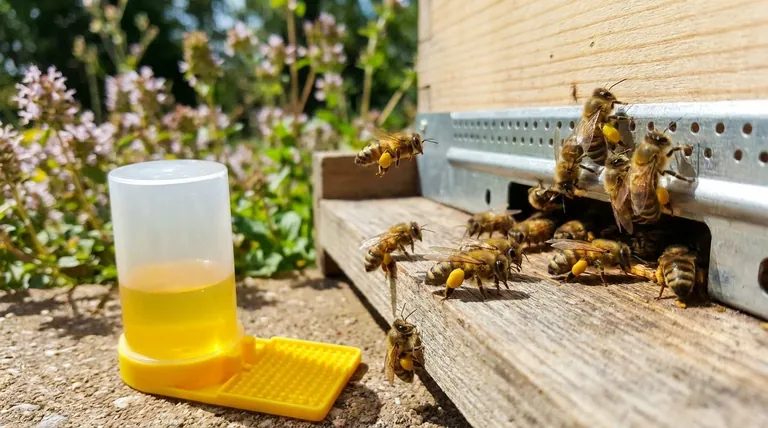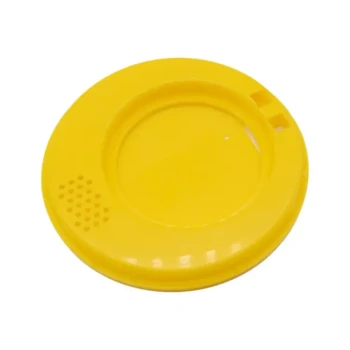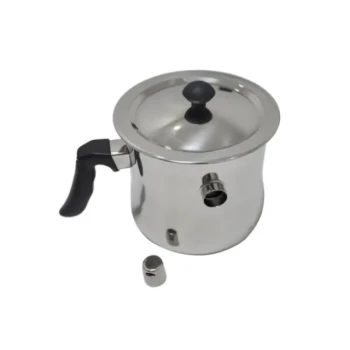For a bee colony, pollen is the essential source of life and growth. It is the hive's primary food source for everything beyond simple energy, providing the critical proteins, fats, vitamins, and minerals necessary to raise new generations of bees and sustain the health of the entire superorganism. Without a steady supply of pollen, a colony cannot grow, reproduce, or survive.
Pollen is not just food; it is the building block of the bee colony itself. While nectar provides the carbohydrates for energy, pollen provides the complex nutrients required to develop larvae, sustain young bees, and empower the queen to lay eggs.
The Foundation of Colony Growth: Pollen as the Sole Protein Source
Pollen is the cornerstone of a hive's ability to expand its population and maintain its workforce.
Fueling the Next Generation
A bee larva's development is entirely dependent on pollen. After a brief diet of royal jelly, larvae are fed a mixture known as bee bread—a fermented blend of pollen, nectar, and bee enzymes stored in comb cells.
This bee bread contains all the proteins, fats, and vitamins required for a larva to grow from a tiny egg into a fully formed pupa. A shortage of pollen directly translates to a reduction in brood rearing.
Sustaining Young Worker Bees
When a new worker bee emerges from her cell, her body is not yet fully developed. She must consume large amounts of pollen for the first several days of her life.
This consumption is critical for developing her hypopharyngeal glands, which are the glands responsible for producing the royal jelly needed to feed the queen and the youngest larvae.
Producing Royal Jelly
Royal jelly is the exclusive food of the queen bee and is what allows her to become a reproductively viable female. It is also fed to all larvae for their first three days.
This vital substance is produced by nurse bees, and their ability to secrete it is directly fueled by the protein and nutrients they derive from consuming pollen. No pollen means no royal jelly, which halts the queen's laying and the rearing of new bees.
Understanding the Trade-offs: Natural Pollen vs. Substitutes
While natural pollen is always superior, beekeepers can intervene with substitutes during times of scarcity. Understanding when and why is crucial.
The Purpose of Pollen Substitutes
Pollen substitutes, often provided as "patties," are a management tool used to stimulate or sustain a colony when natural pollen is unavailable.
This is most common in late winter or early spring to encourage the queen to start laying before natural sources appear, or during a summer "dearth" when flowers are not blooming.
The Limits of Supplementation
Feeding pollen substitutes provides no apparent benefit once natural pollen becomes abundant. Bees will almost always prefer fresh, natural pollen over a substitute.
Providing patties when the colony is already bringing in sufficient natural pollen is a waste of resources and offers no advantage to the hive's health or growth.
Colony Adaptation and Preference
A colony's drive to secure pollen is immense. If their pollen stores are low, the hive will internally regulate its workforce, converting nectar foragers into pollen foragers to meet the demand.
This demonstrates the high priority bees place on pollen. It also explains why some colonies may ignore a pollen substitute entirely if they are able to find even small amounts of a natural source.
Making the Right Nutritional Choice for Your Colony
Applying this knowledge depends entirely on the season, your local environment, and your specific beekeeping goals.
- If your primary focus is rapid spring buildup: Provide a pollen substitute patty early in the season, before natural pollen is available, to stimulate brood rearing and ensure a strong workforce for the first nectar flow.
- If your primary focus is colony survival during a dearth: Monitor the hive entrance for bees returning with pollen and check internal stores. Provide a substitute if you see little to no pollen to prevent a halt in brood rearing.
- If your primary focus is maximizing honey production: Be mindful that stimulating early, massive brood populations with substitutes will create a large population that consumes significant nectar and honey stores before the main flow begins.
Ultimately, ensuring a consistent supply of pollen—whether natural or supplemental—is the most fundamental investment you can make in your colony's long-term health and strength.

Summary Table:
| Aspect | Pollen's Role | Key Impact on Colony |
|---|---|---|
| Larval Development | Provides proteins, fats, vitamins for bee bread | Essential for raising healthy new bees |
| Nurse Bee Health | Fuels hypopharyngeal glands to produce royal jelly | Sustains the queen and youngest larvae |
| Colony Strength | Enables brood rearing and population growth | Determines the hive's ability to survive and thrive |
Ensure your apiary's success with the right nutritional support. HONESTBEE supplies commercial apiaries and beekeeping equipment distributors with high-quality beekeeping supplies and equipment through our wholesale-focused operations. From durable hive components to nutritional supplements, we provide the tools you need to build strong, productive colonies. Contact us today to discuss your apiary's needs and how we can support your business growth.
Visual Guide

Related Products
- HONESTBEE Professional Entrance Bee Feeder Hive Nutrition Solution
- Economy Galvanized Beekeeping Honey Bee Smoker for Wholesale
- Professional Bee Smoker with Elongated Spout and Durable Bellows for Beekeeping
- Professional Galvanized Hive Strap with Secure Locking Buckle for Beekeeping
- Brown Nicot Queen Cell Cups for Breeding Queen Bees Beekeeping
People Also Ask
- What is the best feeder for bees? Choose the Right Feeder for Your Hive's Success
- How do you make an entrance feeder for bees? A Guide to Safe & Effective Hive Feeding
- How is the mesh ladder and barrier installed in the feeder box? A Step-by-Step Guide to Prevent Bee Drowning
- What precautions should be taken when feeding bees inside the hive? Safeguard Your Colony from Robbing and Leaks
- What are the different types of honey bee feeders? Choose the Right Feeder for Your Hive



















